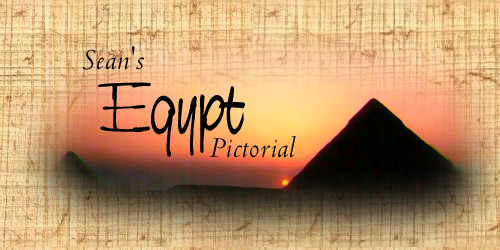The Sound and Light Show... There's a story in and of itself, best told, I think by
excerpts from our journals.
Part I: Getting There (Sean)
"There's a big ol' 'Sound and Light' Show at the Sphinx and the
Pyramids every night, three times a night in a variety of languages. Yes, that's right, you
can smell the cheeze already, but hey it has to be seen!
"We left at about 7:30 thinking that we'd get there in time to see
sunset and the the show. Unfortunately, we seemed to have gotten a mentally handicapped
cab driver.
"Alright, to be fair, the man didn't speak English at all and yes
it's easy enough to get confused between 'The Sphinx' and 'Sphinx Square'. But once we
arrived in Sphinx Square and that was clearly not where we wanted to be you might have made
the connection to THE Sphinx. No. So we explain... 'Sphinx.' He responds, 'Sfinkes?'
(the word's the same in Arabic except for that little 'es' bit) 'Yes, Sfinkes.'
'Sfinkes?!' 'Yes! Sfinkes!' and then a shrug like, 'I don't know WHERE the hell these
foreigners want to go.' So we try another tactic. 'Pyramid. Sphinx.' (appropriate
gestures) 'You know. Haram. (the Arabic word for Pyramid) Giza.' 'Haram?! Giza?!'
'Yes!' Shrug. He calls for help - some passerby that speaks a little more English.
We explain. Our saviour explains. The driver flashes a black-toothed smile, and takes off.
FINALLY, we think. No such luck. It took a total of four more 'saviours' to get us where
we wanted to go - one of whom spoke no more English than the driver and tried to speak to
us in Arabic, another who was in the car next to us while we were travelling at 80 km/hr,
and the gas station attendant where we had to stop for gas! At one point we even pulled out
a map of the Giza plateau and started pointing. At least he didn't have the gall to start
quibbling over the bill."
Well we made it in time for the show, but not for the sunset.
Part II: The Show (Pam)
"The Sound and Light Show costs LE33 to get into, so we took
the advice of the guide book and found a convenient wall to sit on to watch it for free. And
then a guard came along and chased us away. So we went to the wall on the far side of the
lot and climbed it. The guard chased us off of that too. After that we stood and watched
but the view wasn't as good. Anyway, the lighting of the pyramids was very dramatic and
moving, as was most of the music. The narration completely sucked, however; it was cheesy,
over-acted, and completely wandered off the subject towards the end. Still, the pyramids,
blood red against the dark blue sky with the moon overhead was a thrilling and spine-tingling
site (sic). I could only imagine how it must've been a thousand years ago, with out the
light poles, walls, guard shacks, and screaming Arabic kids playing soccer in the background
as a distraction. Of course there wouldn't have been the dramatic lighting then, either..."
Even I will admit that the lighting is pretty impressive. But, I
much prefer the natural light show given every night - the sunset.
Sadly, even these magnificent and peaceful pictures were hard won (Pam):
"We ate dinner at the Pizza Hut that the Sphinx is doomed to stare at,
and then we walked through the Islamic cemetary and up a hillside to find a vantage point
from which to watch the sunset in relative peace and quiet. True to the nature of Egypt,
we were continually pestered, and finally chased off the cliff, all because of the stupid
Sound and Light show. You cannot just sit and watch the sun go down at the pyramids anymore,
even from the desert. It just so perfectly underscores the whole theme of economic
exploitation that modern Egypt holds towards ancient Egpyt. It is annoying and frustrating.
Dejectedly, we went back to the hotel."
This incident was our final visit to the plateau on the last night
of our trip. As you might have gleaned, by that time we were beginning to feel a little
cynical.
1. This may, in fact, not be true. The Osierion at Abydos shares a number of
the characteristics of the Valley Temple - more information will follow in the appropriate
chapter.
2. I reccomend: Hancock, Graham, Fingerprints of the Gods; Bauval, Robert and Adrian Gilbert, The Orion Mystery;
and Bauval, Robert and Graham Hancock, Keeper of Genesis - in that order.
3. The oldest known version of Egyptian Funerary texts inscribed on the walls
of the Pyramid of Unas at Saqqara.






